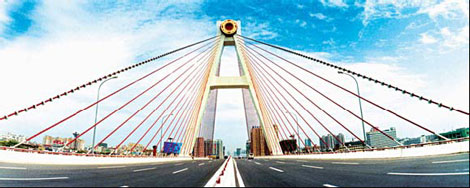


Although it has been 11 years since Chongqing, formerly the largest city in Sichuan province, became a municipality directly under central administration, many Chinese would still mistake Chongqing for part of Sichuan.
The municipality has close ties with Chengdu, Sichuan province's capital, in sharing almost the same dialect, spicy food and hot pot dish.
With many similarities, both cities are pinning hopes on the construction of the Chengdu-Chongqing Economic Zone to become an engine of economic growth for the country's vast western region.
Centered on both cities, the zone incorporates 14 cities of Sichuan and 23 districts and counties of Chongqing.
The zone, with an area of 155,000 sq km, about a quarter of the total area of Sichuan and Chongqing, has a population of 80 million and contribute more than half of the combined GDP of the two regions.
The two cities have decided to join forces to merge their advantages and seek mutual development through even closer economic ties and collaboration.
"We will try to win the central government's consent to list the economic zone as a State-level key development zone and receive more support in infrastructure investment, and prepare for the industrial transfer from the more developed coastal areas into the area," said Wang Huaichen, vice-governor of Sichuan.
The economic zone will become the biggest city cluster in western China and its aim is to become another regional economic powerhouse like the Yangtze River Delta, Pearl River Delta and the Bohai Bay Region, Wang said.
They will give priority to the construction of infrastructure, such as speeding up point-to-point fast passage and road linking the two cities.
Yang Qingyu, director of the development and reform commission of Chongqing, said a rapid rail link between Chongqing and Chengdu, which is expected to be finished by 2010, will cut travel time to one and half hours between the two cities.
It is expected that the area, which now accounts for about 5 percent of the national GDP, will leap to 10 percent in another five to 10 years.
The National Development and Reform Commission (NDRC), China's top economic planner, has approved the establishment of new experimental zones for urban-rural comprehensive reform in Sichuan and Chongqing.
Unlike special economic zones such as Shenzhen in South China's Guangdong province, the experimental zones are piloting reforms aimed at reducing, and eventually eliminating, the income gap between rural and urban areas.
"The selection of the two pilot cities is necessary to explore a coordinated development model in China," explained Yang Weimin, an NDRC official.
China, which has witnessed rapid economic growth since it launched reform and opening-up policies in 1978, has also seen a widening income gap between rural and urban areas.
The per capita net income of farmers was 3,587 yuan last year, while the per capita disposable income of urban residents was 11,759 yuan, about 2.3 times more.
Most of China has long felt the effect of this gap. The sharp decrease in the amount of arable land and the mechanization of farming have pushed millions of farmers to find jobs in cities over the past few decades.
With rural income five to six times lower than city earnings, those left behind to farm the land rely on these migrant workers for cash.
What is deeply worrying is that the urban-rural income gap has been widening in recent years because of the structural barriers depriving rural residents of equal rights.
The action taken by some local governments to register all households as residents, rather than rural or urban, has pioneered the change of this unfair structure.
Pension distribution and other types of social security already delivered to rural residents in some localities are also helping close the urban-rural gap.
The two southwestern cities designated as experimental zones are of particular significance as rural residents make up more than half of each city's population. If successful, their experience will, hopefully, be extended nationwide, according to the NDRC.
(China Daily 08/25/2008 page3)













